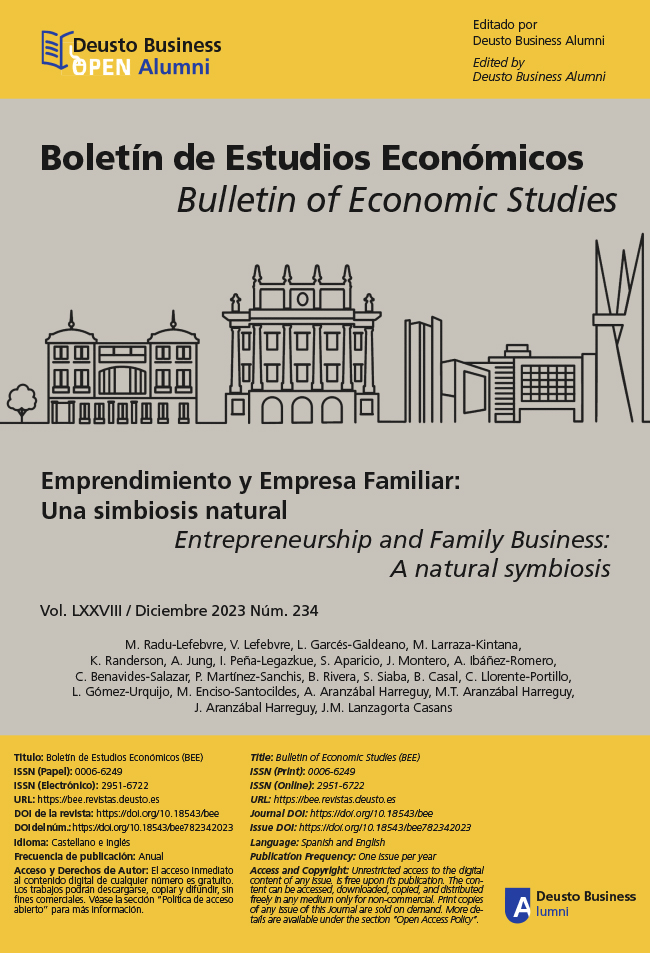Emprendimiento y empresa familiar: ¿dos disciplinas hermanas o distintas?
Resumen
El emprendimiento y la empresa familiar ¿son dos disciplinas hermanas o distintas? Ambas son disciplinas con entidad propia, pero desde el inicio ambas han estado fuertemente conectadas. De hecho, las empresas familiares han sido consideradas como un elemento central del proceso emprendedor donde la influencia de la familia es particularmente relevante en las primeras etapas de la creación de la empresa. Sin embargo, la etapa inicial de estas empresas ha sido poco explorada. Este artículo tiene un doble objetivo. En primer lugar, proporciona una pequeña perspectiva histórica de la evolución de las dos disciplinas académicas y sus interrelaciones, y, en segundo lugar, trata de resumir las principales conclusiones de la escasa literatura sobre la perspectiva del arraigo familiar que estudia el binomio familia-emprendimiento. Por último, el trabajo propone diferentes líneas de investigación para futuros estudios relacionados con la empresa familiar y el emprendimiento.
Recibido: 26 de abril de 2023
Aceptado: 05 de octubre de 2023
Citas
Aldrich, H. E., & Cliff, J. E. (2003). The Pervasive Effects of Family on Entrepreneurship: Toward a Family Embeddedness Perspective. Journal of Business Venturing, 18(5), 573–596. https://doi.org/10.1016/s0883-9026(03)00011-9
Anokhin, S., & Wincent, J. (2012). Start-up rates and innovation: A cross-country examination. Journal of International Business Studies. 43, 41-60. https://doi.org/10.1057/jibs.2011.47
Arregle, J. L., Batjargal, B., Hitt, M. A., Webb, J. W., Miller, T., & Tsui, A. S. (2015). Family ties in entrepreneurs’ social networks and new venture growth. Entrepreneurship theory and Practice, 39(2), 313-344. https://doi.org/10.1111/etap.12044
Au, K., & Kwan, H. K. (2009). Start-up Capital and Chinese Entrepreneurs: The Role of Family. Entrepreneurship Theory and Practice, 33(4), 889–908. https://doi.org/10.1111/j.1540-6520.2009.00331.x
Capelleras, J. L., Contin-Pilart, I., Larraza-Kintana, M., & Martín-Sánchez, V. (2019). Entrepreneurs’ human capital and growth aspirations: The moderating role of regional entrepreneurial culture. Small Business Economics, 52, 3-25. https://doi.org/10.1007/s11187-017-9985-0
Chirico, F., & Nordqvist, M. (2010). Dynamic capabilities and trans-generational value creation in family firms: The role of organizational culture. International Small Business Journal, 28(5), 487–504. https://doi.org/10.1177/0266242610370402
Colombo, S., & Grilli, L. (2017). Should I stay or should I go? Founder’s decision to leave an entrepreneurial venture during an industrial crisis. Industry and Innovation, 24(2), 97-121. https://doi.org/10.1080/13662716.2016.1216395
Davidsson, P., & Honig, B. (2003). The role of social and human capital among nascent entrepreneurs. Journal of Business Venturing, 18 (5), 301-331. https://doi.org/10.1016/s0883-9026(02)00097-6
De Massis, A., Frattini, F., Pizzurno, E., & Cassia, L. (2015). Product innovation in family versus nonfamily firms: An exploratory analysis. Journal of Small Business Management, 53(1), 1-36. https://doi.org/10.1111/jsbm.12068
Galve-Górriz, C., & Salas-Fumás, V. (2003). La Empresa Familiar en España: Fundamentos Económicos y Resultados. Fundación BBVA, Bilbao. https://doi.org/10.2139/ssrn.664538
Gartner, W. B., & Birley, S. (2002). Introduction to the Special Issue on Qualitative Methods in Entrepreneurship Research. Journal of Business Venturing, 17(5), 387-395. https://doi.org/10.1016/s0883-9026(01)00077-5
Gómez-Mejía, L. R., Makri, M., & Kintana, M. L. (2010). Diversification decisions in family-controlled firms. Journal of Management Studies, 47 (2), 223-252. https://doi.org/10.1111/j.1467-6486.2009.00889.x
Hahn, D., Spitzley, D. I., Brumana, M., Ruzzene, A., Bechthold, L., Prügl, R., & Minola, T. (2021). Founding or succeeding? Exploring how family embeddedness shapes next generation members’ entrepreneurial intentions. Technology Forecasting and Social Change, 173, 121-182. https://doi.org/10.1016/j.techfore.2021.121182
Hermans, J., Vanderstraeten, J., Van Witteloostuijn, A., Dejardin, M., Ramdani, D., & Stam, E. (2015). Ambitious Entrepreneurship: A Review of Growth Aspirations, Intentions, and Expectations. Entrepreneurial Growth: Individual, Firm, and Region (Advances in Entrepreneurship, Firm Emergence and Growth, Vol. 17), Emerald Group Publishing Limited, Bingley, 127-160. https://doi.org/10.1108/s1074-754020150000017011
Instituto de la Empresa Familiar (2015). La Empresa Familiar en España (2015).
Jaskiewicz, P., Combs, J. G., Rau, S. B., & De Massis, A. (2017). Entrepreneurial legacy: Toward a theory of how some family firms nurture transgenerational entrepreneurship. Journal of Business Venturing, 32(5), 519-535. https://doi.org/10.1016/j.jbusvent.2014.07.001
Lee, S. M., & Lee, B. (2015). Entrepreneur characteristics and the success of venture exit: An analysis of single-founder start-ups in the US. International Entrepreneurship and Management Journal, 11, 891-905. https://doi.org/10.1007/s11365-014-0324-5
Mole, K., & Ram, M. (2012). Perspectives in entrepreneurship: A critical approach. Palgrave Mcmillan, New York, NY.
OCDE (2021). OECD SME and Entrepreneurship Outlook 2021, OECD Publishing, Paris. https://doi.org/10.1787/97a5bbfe-en
Pittino, D., Chirico, F., Baù, M., Villasana, M., Naranjo-Priego, E. E., & Barron, E. (2020). Starting a family business as a career option: The role of the family household in Mexico. The Journal of Family Business Strategy, 11 (2), 100338. https://doi.org/10.1016/j.jfbs.2020.100338
Rogoff, E. G., & Heck, R. K. Z. (2003). Evolving research in entrepreneurship and family business: Recognizing family as the oxygen that feeds the fire of entrepreneurship. Journal of Business Venturing, 18(5), 559-566. https://doi.org/10.1016/s0883-9026(03)00009-0
Sharma, P., Chrisman, J. J. & Chua, J. H. (1997). Strategic management of the family business: Past research and future challenges. Family Business Review, 10 (1), 1-35. https://doi.org/10.1111/j.1741-6248.1997.00001.x
Sharma, P., Chrisman, J. J., & Gersick, K. E. (2012). 25 years of Family Business Review: Reflections on the past and perspectives for the future. Family Business Review, 25 (1), 1-15. https://doi.org/10.1177/0894486512437626
Sharma, P., & Manikutty, S. (2005). Strategic Divestments in Family Firms: Role of Family Structure and Community Culture. Entrepreneurship Theory and Practice, 29(3), 293–311. https://doi.org/10.1111/j.1540-6520.2005.00084.x
Sharma, P. (2008). Commentary: Familiness: Capital Stocks and Flows between Family and Business. Entrepreneurship Theory and Practice, 32(6), 971-977.
https://doi.org/10.1111/j.1540-6520.2008.00266.x
Short, J. C., Sharma, P., Lumpkin, G. T., & Pearson, A. W. (2016). Oh, the places we’ll go! Reviewing past, present, and future possibilities in family business research. Family Business Review, 29 (1), 11-16. https://doi.org/10.1177/0894486515622294
Sieger, P., & Minola, T. (2017). The Family’s Financial Support as a “Poisoned Gift”: A Family Embeddedness Perspective on Entrepreneurial Intentions. Journal of Small Business Management, 55, 179-204. https://doi.org/10.1111/jsbm.12273
Steier, L. (2003). Variants of Agency Contracts in Family-Financed Ventures as a Continuum of Familial Altruistic and Market Rationalities. Journal of Business Venturing, 18(5), 597–618. https://doi.org/10.1016/S0883-9026(03)00012-0
Thornton, P. H., Ocasio, W., & Lounsbury, M. (2012). The institutional logics perspective: A new approach to culture, structure, and process. Oxford University Press.
Wright, M., & Stigliani, I. (2013). Entrepreneurship and growth. International Small Business Journal, 31(1), 3–22. https://doi.org/10.1177/0266242612467359
Licencia:
Los trabajos publicados en esta revista desde 2021 se encuentran disponibles bajo la licencia Creative Commons Attribution-NonCommercial 4.0 International - CC BY-NC 4.0. La actual política de acceso abierto de la revista no se aplica a los contenidos previos 2021.
Derechos de los autores/as:
Los autores y las autoras conservan los derechos de autor/a sobre sus trabajos publicados en el Boletín de Estudios Económicos y conceden a éste derechos no exclusivos para la explotación de los trabajos con fines de maquetación, publicación y difusión. Esta licencia permite al Boletín de Estudios Económicos distribuir, reproducir y difundir los trabajos en su plataforma y otros medios, siempre bajo las condiciones descritas en este aviso.
Derechos de los lectores/as:
Los lectores y las lectoras pueden leer, descargar, imprimir, buscar, compartir (copiar, redistribuir o enlazar textos completos), o adaptar (remezclar, transformar y construir a partir del material) el contenido, siempre que:
- No se utilicen los materiales con fines comerciales.
- Se cite adecuadamente el trabajo original, incluyendo el nombre de la persona autora y la fuente.
- Se indique claramente cualquier modificación realizada al contenido original.
El uso comercial de los materiales está prohibido sin el permiso expreso de las personas autoras. Para mayor claridad, se considera uso comercial cualquier actividad que tenga como fin la obtención de beneficios económicos o que implique un intercambio comercial directo.
Condiciones de uso:
El uso del contenido no debe infringir los derechos de otras personas, ni debe ser utilizado de manera que pueda dañar la reputación del/la autor/a o del Boletín de Estudios Económicos.
Responsabilidad por el contenido:
Los/las autores/as son responsables del contenido de sus trabajos y el Boletín de Estudios Económicos no se hace responsable de las opiniones expresadas en los mismos.
Más información:
Política de Acceso Abierto, Licencia y Derechos de Autor/a


.jpg)
.jpg)
.jpg)







